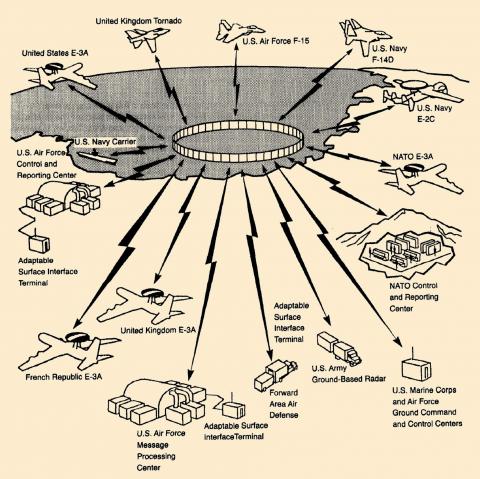A deal to purchase an upgraded naval vessel communications system worth NT$2.15 billion (US$68.18 million) has been finalized with the US government, a high-ranking Taiwanese military officer said yesterday.
The officer, who declined to be named, said the deal secured the purchase of upgraded Link-16 and Link-11 systems, which would connect the Republic of China (ROC) Navy directly to the command center for the US’ Pacific fleet.
The system will give the ROC Navy the ability to share coordinates and other information with the US Seventh Fleet during combat operations, the officer said, adding that the move ties the two navies closer together.

Image in the public domain provided by Wikimedia Commons
The systems are already in use by NATO members and the US’ other allies in the Pacific, the officer said, adding that information can be shared among all allies during combat operations should the need arise.
The US can direct all of its allies in the field to coordinate operations, the officer said.
The officer said some of the ROC Navy’s ships would use the Link-16 system, which will connect those ships to other vessels, land-based radar systems and other military installations.
Kidd-class destroyers, Cheng Kung-class frigates, Lafayette-class frigates and Knox-class frigates would all use the Link-16 system, the officer said, adding that missile-equipped patrol ships and support vessels would use the Link-11 system, which only connects with other vessels.
The officer said the deal was rushed through with coordination between the American Institute in Taiwan and military representatives stationed in the US, adding that shipment and installation of the systems are expected to be completed by June 2021.
The officer said that while the systems’ main components are to be acquired from the US, communications and photoelectric components would be produced by domestic manufacturers.
Democratic Progressive Party (DPP) Legislator Lo Chih-cheng (羅致政) said that control over information is at the heart of armed conflict.
An effective means to transmit information is fundamental to military strategy, Lo said, adding that the procurement of the Link-16 and Link-11 systems would greatly benefit the nation’s military.
DPP Legislator Wang Ding-yu (王定宇) said the process of military cooperation with allies in the region began late last year when Taiwan, Japan and the US communicated military aircraft identifier signal information with each other, adding that Japan included contingencies for a possible conflict in the Taiwan Strait among recent training activities.
Outcomes in modern military conflicts are decided within seconds, Wang said, adding that the systems would dramatically improve the military’s reaction time and allow for rapid coordination of movements.
Additional reporting by Aaron Tu

People can preregister to receive their NT$10,000 (US$325) cash distributed from the central government on Nov. 5 after President William Lai (賴清德) yesterday signed the Special Budget for Strengthening Economic, Social and National Security Resilience, the Executive Yuan told a news conference last night. The special budget, passed by the Legislative Yuan on Friday last week with a cash handout budget of NT$236 billion, was officially submitted to the Executive Yuan and the Presidential Office yesterday afternoon. People can register through the official Web site at https://10000.gov.tw to have the funds deposited into their bank accounts, withdraw the funds at automated teller

PEACE AND STABILITY: Maintaining the cross-strait ‘status quo’ has long been the government’s position, the Ministry of Foreign Affairs said Taiwan is committed to maintaining the cross-strait “status quo” and seeks no escalation of tensions, the Ministry of Foreign Affairs (MOFA) said yesterday, rebutting a Time magazine opinion piece that described President William Lai (賴清德) as a “reckless leader.” The article, titled “The US Must Beware of Taiwan’s Reckless Leader,” was written by Lyle Goldstein, director of the Asia Program at the Washington-based Defense Priorities think tank. Goldstein wrote that Taiwan is “the world’s most dangerous flashpoint” amid ongoing conflicts in the Middle East and Russia’s invasion of Ukraine. He said that the situation in the Taiwan Strait has become less stable

CONCESSION: A Shin Kong official said that the firm was ‘willing to contribute’ to the nation, as the move would enable Nvidia Crop to build its headquarters in Taiwan Shin Kong Life Insurance Co (新光人壽) yesterday said it would relinquish land-use rights, or known as surface rights, for two plots in Taipei’s Beitou District (北投), paving the way for Nvidia Corp to expand its office footprint in Taiwan. The insurer said it made the decision “in the interest of the nation’s greater good” and would not seek compensation from taxpayers for potential future losses, calling the move a gesture to resolve a months-long impasse among the insurer, the Taipei City Government and the US chip giant. “The decision was made on the condition that the Taipei City Government reimburses the related

FRESH LOOK: A committee would gather expert and public input on the themes and visual motifs that would appear on the notes, the central bank governor said The central bank has launched a comprehensive redesign of New Taiwan dollar banknotes to enhance anti-counterfeiting measures, improve accessibility and align the bills with global sustainability standards, Governor Yang Chin-long (楊金龍) told a meeting of the legislature’s Finance Committee yesterday. The overhaul would affect all five denominations — NT$100, NT$200, NT$500, NT$1,000 and NT$2,000 notes — but not coins, Yang said. It would be the first major update to the banknotes in 24 years, as the current series, introduced in 2001, has remained in circulation amid rapid advances in printing technology and security standards. “Updating the notes is essential to safeguard the integrity